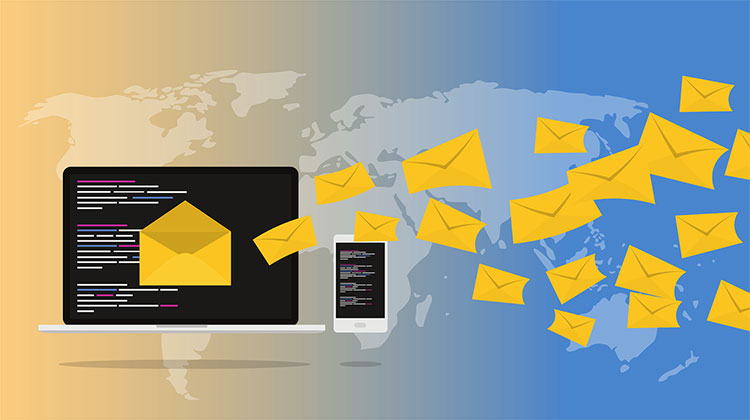Does email marketing work?
When our team was just starting out, we had a preconceived notion that email marketing was outdated. We thought, “Why would a business waste hours on creating emails that were going to inevitably be sent to the trash or spam folder?”
Boy, were we wrong. We quickly learned that email marketing was and continues to be a very valuable technique to retain users, keep them loyal to your brand, and guide them through the buying journey.
Email marketing is also a very cost effective form of marketing. A study completed in 2015 by the DMA reported that for every £1 spent on email marketing, an average return of £38 could be expected. This was a huge increase from the £24.93 reported just two years before. There are few strategies or techniques proven to be as successful for return on investment as email marketing.
What is email marketing?
Email marketing is pretty self explanatory. A business builds an email list (hopefully of opted-in candidates), creates emails that drive users to a task, and strategically send those emails to their contact list.
These emails can be weekly or monthly newsletters, new product releases, news, updates, deals, sales, reminders, etc. You can also use programs that send automated emails reminding users of abandoned carts, coupon codes or deals they haven’t used yet, welcome messages, or birthday wishes.
Retain customers and increase brand loyalty
Each email is a reminder that the brand exists and cares enough to reach out to their customers. An email can be a nudge that convinces your user to return to an abandoned cart, an invite to follow on social media, or a deal the user can’t help but return to use. If your brand is memorable, your customer is much more likely to use your services or buy your products in the future.
Email marketing and CRM
Email marketing can be an important portion of your customer relationship management (CRM.) CRM is a strategy that analyzes data about the history of users interacting with your brand to improve your future interactions and maintain a relationship with your customer. By evaluating the customer and their previous history with your business, you can better interact with that customer and more accurately target future users.
A CRM system can be invaluable to a business and there are many to choose from that can be integrated into your website and analytics. Our go-to is a free CRM by Hubspot. It’s simple to install, easy to use, and best of all, it’s totally free. IntellaSphere is another CRM with a free option worth noting. They also have paid tiers with features that may be valuable to your business.
How do you build an email subscriber list?
It can be vastly important for a business to build a subscriber list. These users opt in for future promotional ads and can be used again and again, as long as they stay subscribed. You can advertise the benefits of becoming a subscriber on your website or you can automatically opt in users who sign up or make an account on your website.
The first step to building a subscriber list is to create a sign-up form on your website. You can build a pop up that directs users to sign up when they first view the site, or you can pepper it around the website, in blogs, on social media, or even paid ads. Even placing a sign up form at a physical event or tradeshow can add more subscribers to your list. The strategies are up to you and the avenues you see fit to best advertise your newsletter.
Incentivize subscriptions
Entice users to sign up by offering an incentive for the use of their email. No one wants to sign up for spam. This can be a deal, discount code, free product, important or useful articles or information, contest entry, etc. The sky's the limit. Just make sure what you’re offering is enough to encourage users to sign up. Don’t bait and switch. You’re likely to lose the subscriber if they don’t receive what was promised.
Why you shouldn’t buy email lists
You may receive offers to buy email lists, though we don’t recommend this because it’s a shady tactic to email users who haven’t blatantly opted in to your ads. In a worst case scenario, it can get your mailing platform account, email, or even the entire domain shut down by Icann.
Don’t get sent to spam!
If an email gets flagged as spam, all other emails you send that user will be sent to spam, losing a valuable subscriber along the way. If enough of your emails are marked as spam, Google and other email platforms may mark your entire email as a source of spam and direct every email you send straight to spam folders. It’s also likely to affect other people using the same servers as you to send the email. This is just a bad move for everyone involved. You may also waste money on emails that aren’t even real or useful. The best technique is to offer a benefit and let the subscribers come to you.
Where should my emails direct users?
Your emails should direct users to satisfy your goals. If your goal is to increase users’ time on page, sending them to a blog article may be advantageous. If the goal is to increase sales, sending them to your shop page or a specific product could help. If you want to get more likes or followers on social media, sending them to some great content on your profile may be just the boost you need. Each email should have a goal and the links in your email should drive all users to attain your goals.
Compelling Calls to Action
Be sure to use powerful CTAs (calls to action) in your emails and make them really obvious. You could use “buy now” or “learn more,” but those CTAs don’t really invoke a strong feeling in your user and are less likely to convince your user to click than a CTA that makes them curious to see what’s behind the button. A stronger CTA in this case would be “take the test and find out…” or “discover your true…” or “get your free…” I like to make my links bright, unmistakable buttons so they can’t be missed.
When should I email my subscribers?
All the time. It may seem like spam to you, but reminding your users your brand exists is vastly important. Monthly or weekly newsletters are pretty reasonable and are unlikely to overwhelm a user as long as the content is valuable. Use these to update your user on new releases and sales, events, etc.
Sometimes you can get away with multiple emails a week if you’re offering something worthwhile or reminding users that “time is running out” on a great deal, though you can definitely lose subscribers this way if you do it too often.
How can I send many emails without seeming spamy?
The best strategy to send many emails without scaring away subscribers is to offer valuable content in your emails. Users are likely to stay engaged if they are receiving great deals or information they actually want to use.
Your emails must also employ attention-grabbing or enticing subject lines and excerpts, otherwise they can get lost in their sea of emails. Also ensure your emails are clear, visually pleasing, and free from spelling or grammar errors. Spelling and grammar errors are usually a quick indicator of spam mail.
What mass email platforms can I use?
There are many options for mass emailing platforms. Mailchimp offers 2,000 contacts with 10,000 free emails a month with paid plans for users that need to send more. Hubspot CRM free marketing tools offer 2,000 emails per month with a paid upgraded version. Constant Contact offers unlimited emails starting at $20 a month, so it’s a great contender to consider for a business that needs to send a lot of emails for a small investment. Most platforms offer customizable templates and make designing custom emails fast and easy. These platforms also give analytics on the campaigns and customers.
The price and feature differentiation between platforms is vast. The paid plans for Mailchimp start at $9.99 and the paid version of Hubspot’s marketing tools cost $800 per month. The services provided by each platform overlap and vary, so it’s really up to you and your needs to determine what platform will be best for your business.
How do I track campaigns?
Your chosen email platform should do most of the work. You can use their analytics and integrate them with your CRM to really dive deep into the data. The email platform should track open rate and click through rate on its own.
And adding unique tracking codes (UTM) to your emails can help you record the customer’s journey. A UTM tracking code is a URL that redirects to your landing page so you can track which users are coming from your email. Without a UTM tracking code, it’s difficult to identify which users that visited your website came from the email.
Depending on the platform and features, you can also A/B test your emails to determine the successfulness of each email structure, offer, call to action, etc. This is also valuable for categorizing your subscribers. If you find some users are more likely to buy, complete a desired action, or just interact more with specific types of emails, you can separate them from the main list and market to them differently than the rest of your subscribers.
Conclusion
Email marketing is an invaluable tool for many businesses. Its low cost and high return on investment makes it one of the best tactics you can implement to retain customers and boost conversions. At Symphysis, we highly recommend implementing an email strategy and offer consulting to help your team make the most of your email marketing strategies. Contact us today to speak with one of our consultants.



